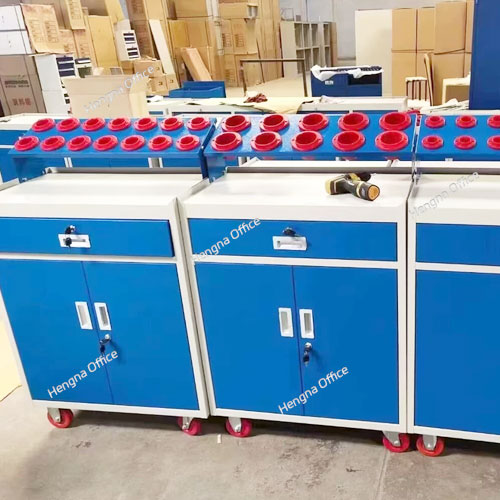1. Consider the Material
When it comes to a factory heavy – duty tool cabinet, the material is of utmost importance. The most common and reliable material is cold – rolled steel. Cold – rolled steel offers excellent strength and durability, which is essential for withstanding the rough and tumble of a factory environment. It can bear heavy loads without deforming or breaking easily. For example, if you plan to store large power tools or heavy equipment parts in the cabinet, cold – rolled steel will ensure that the cabinet remains intact over time.
Another aspect to consider regarding the material is its resistance to corrosion. Factories often have environments with moisture, chemicals, or oils. A tool cabinet made of steel with a proper anti – corrosion treatment, such as powder coating or galvanization, will last longer. Powder – coated tool cabinets not only look sleek but also provide a protective layer against rust and scratches. Galvanized steel, on the other hand, offers a high level of corrosion resistance, especially in humid conditions.
2. Evaluate the Structure and Design
The structure of the tool cabinet should be well – thought – out. Look for a cabinet with a solid frame construction. A cabinet with a welded or bolt – together frame will be more stable and less likely to shake or wobble, even when fully loaded. Additionally, the number and arrangement of compartments and drawers matter.
Drawers are crucial for organizing smaller tools and parts. They should be equipped with high – quality slides that can support the weight of the items inside and allow for smooth opening and closing. Full – extension slides are a great feature as they enable you to access all the contents of the drawer easily. Compartments, on the other hand, are useful for storing larger tools or equipment. Consider the height and width of the compartments to ensure they can accommodate your specific tools.
Some heavy – duty tool cabinets also come with adjustable shelves. This is a very convenient feature as it allows you to customize the interior space according to the size of your tools. For instance, if you have some tall power drills, you can adjust the shelf height to fit them.
3. Check the Mobility and Additional Features
Mobility can be a significant advantage in a factory setting. If you need to move the tool cabinet around the factory floor, look for one with high – quality casters. The casters should be able to support the weight of the fully – loaded cabinet and offer smooth movement. Locking casters are even better as they can keep the cabinet in place when needed, providing stability during tool retrieval.
Additional features can also enhance the functionality of the tool cabinet. For example, some cabinets come with built – in tool holders or pegboards. These features help you keep your tools organized and easily accessible. A tool cabinet with a locking mechanism is also a must – have, especially if you have valuable or dangerous tools. It ensures the security of your tools and prevents unauthorized access.
In conclusion, choosing the right factory heavy – duty tool cabinet requires careful consideration of the material, structure and design, as well as mobility and additional features. By taking these factors into account, you can select a tool cabinet that will serve you well in your factory for years to come.




